Acute Pancreatitis Dr. Eddie Koifman Gastroenterology Dpt. RAMBAM

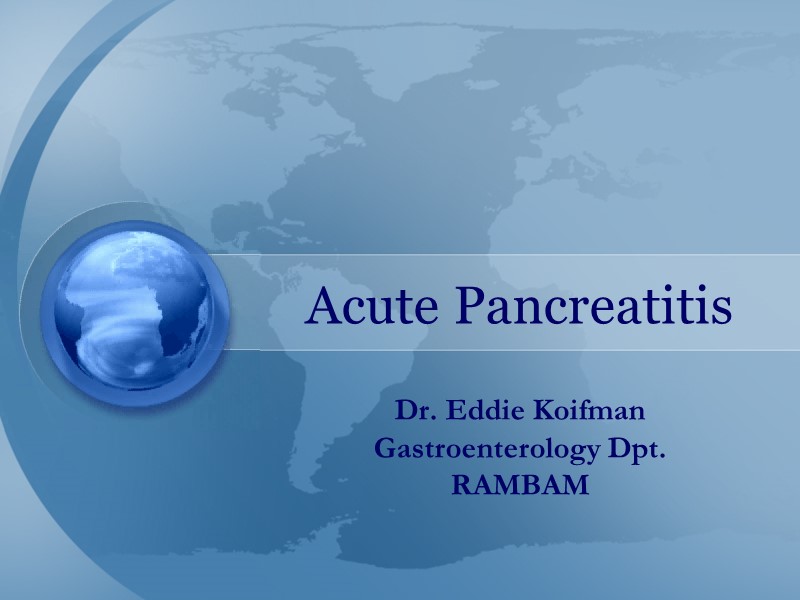
Acute Pancreatitis Dr. Eddie Koifman Gastroenterology Dpt. RAMBAM
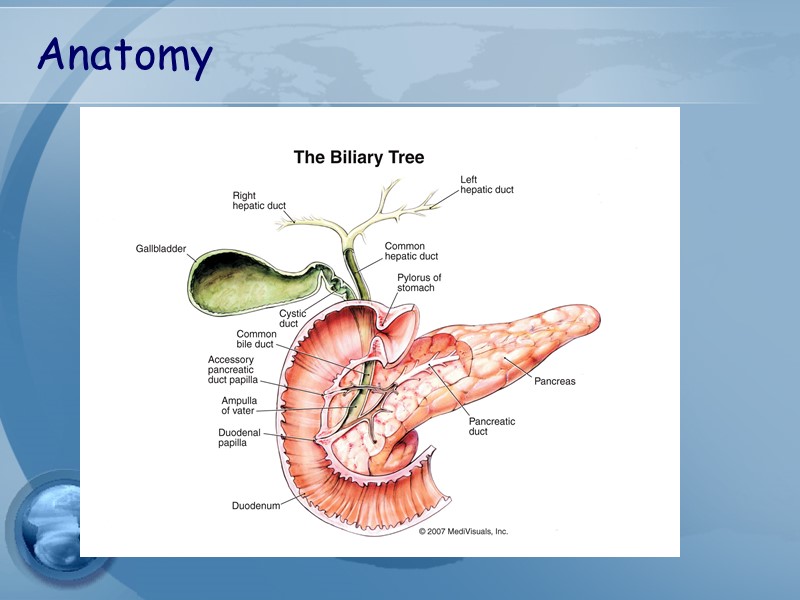
Anatomy
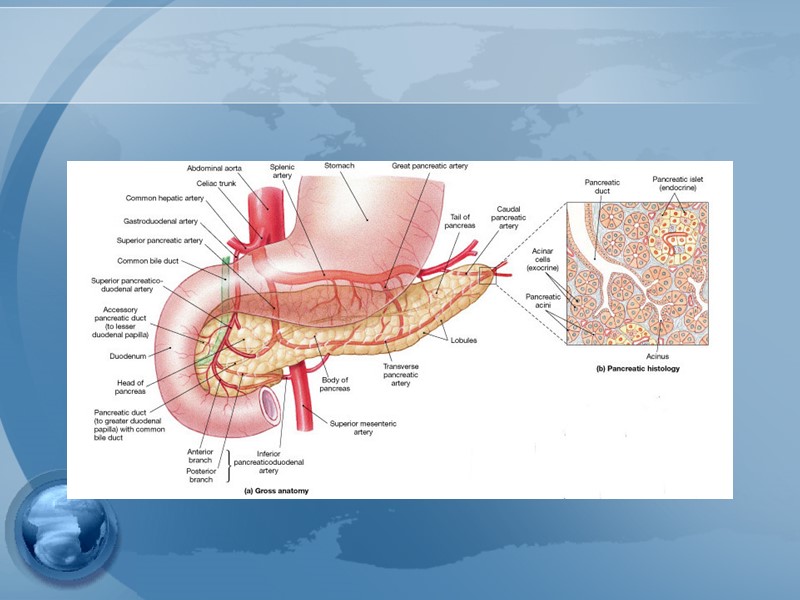
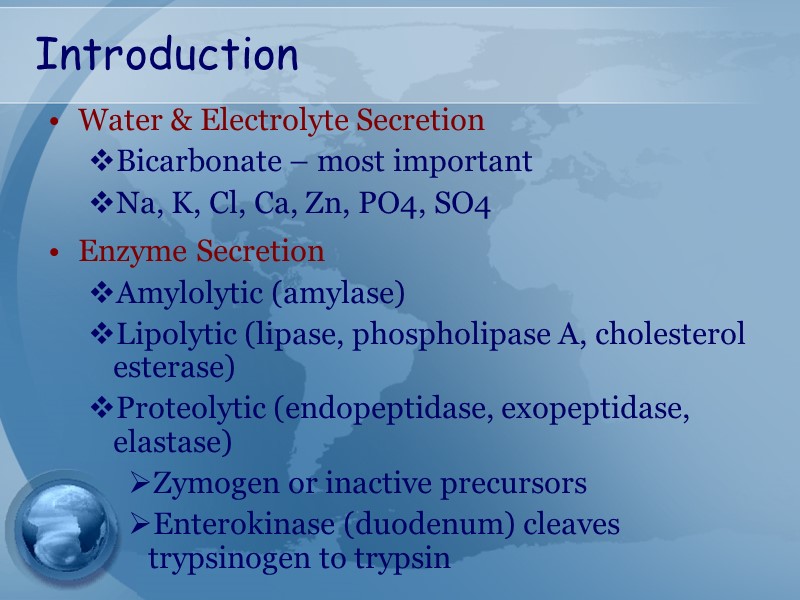
Introduction Water & Electrolyte Secretion Bicarbonate – most important Na, K, Cl, Ca, Zn, PO4, SO4 Enzyme Secretion Amylolytic (amylase) Lipolytic (lipase, phospholipase A, cholesterol esterase) Proteolytic (endopeptidase, exopeptidase, elastase) Zymogen or inactive precursors Enterokinase (duodenum) cleaves trypsinogen to trypsin
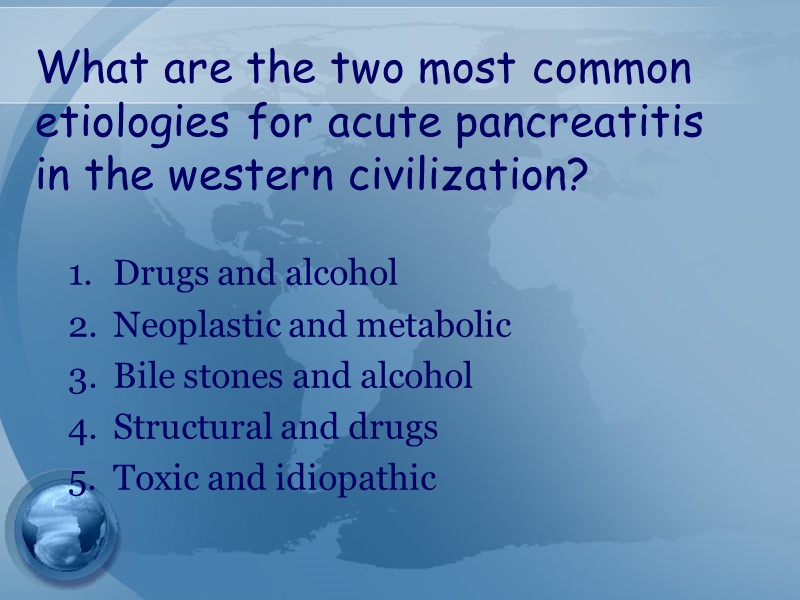
What are the two most common etiologies for acute pancreatitis in the western civilization? Drugs and alcohol Neoplastic and metabolic Bile stones and alcohol Structural and drugs Toxic and idiopathic
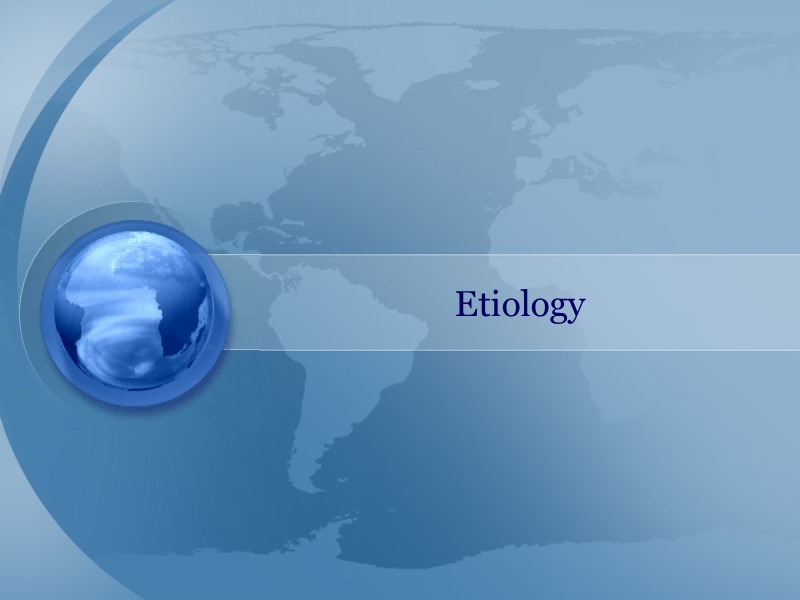
Etiology
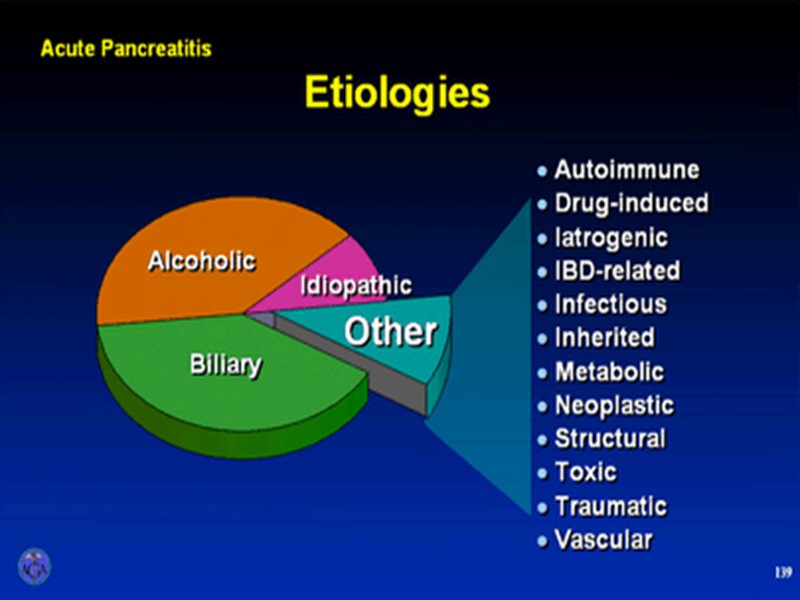
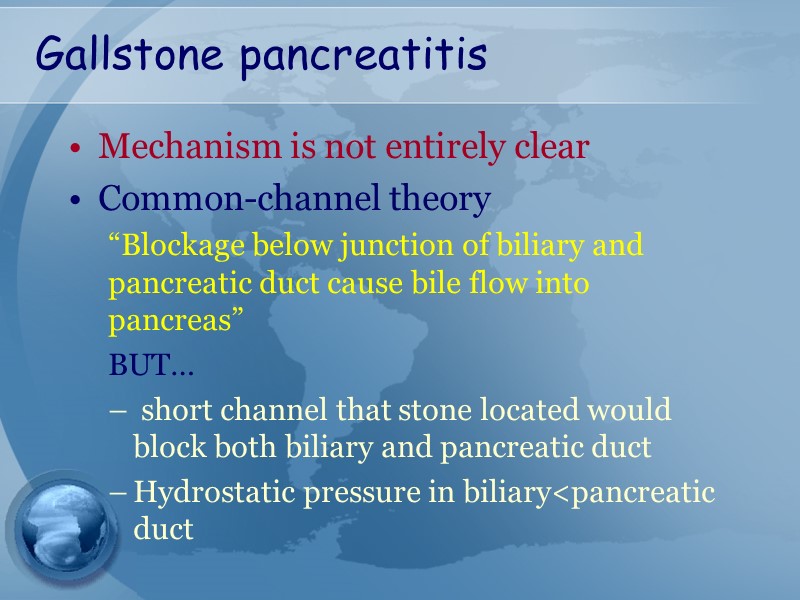
Gallstone pancreatitis Mechanism is not entirely clear Common-channel theory “Blockage below junction of biliary and pancreatic duct cause bile flow into pancreas” BUT… short channel that stone located would block both biliary and pancreatic duct Hydrostatic pressure in biliary
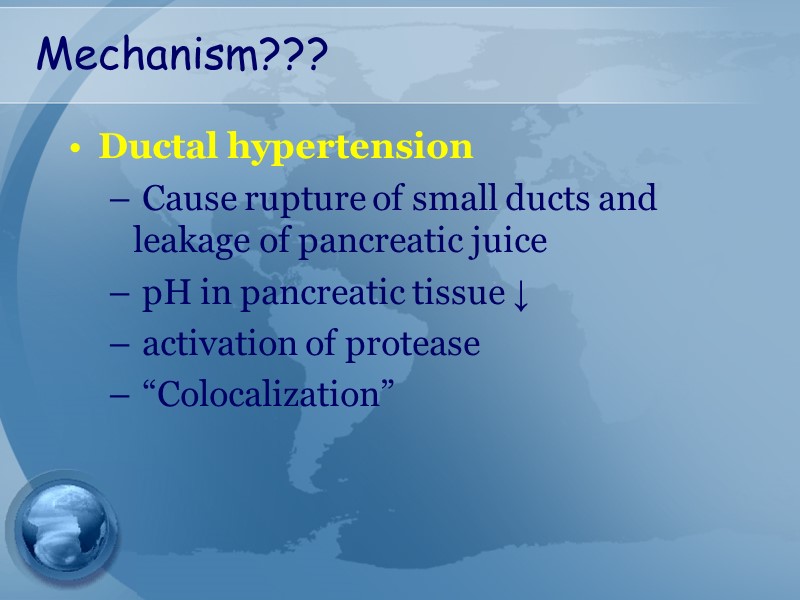
Mechanism??? Ductal hypertension Cause rupture of small ducts and leakage of pancreatic juice pH in pancreatic tissue ↓ activation of protease “Colocalization”
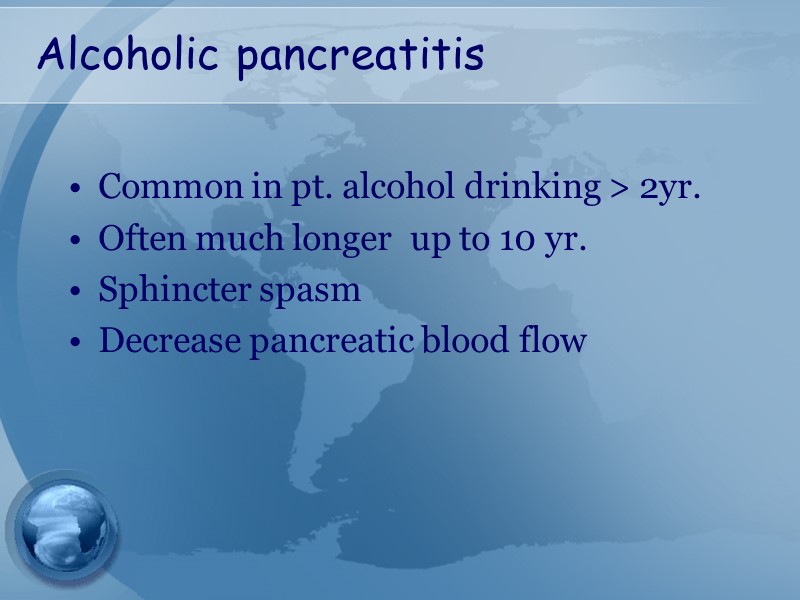
Alcoholic pancreatitis Common in pt. alcohol drinking > 2yr. Often much longer up to 10 yr. Sphincter spasm Decrease pancreatic blood flow
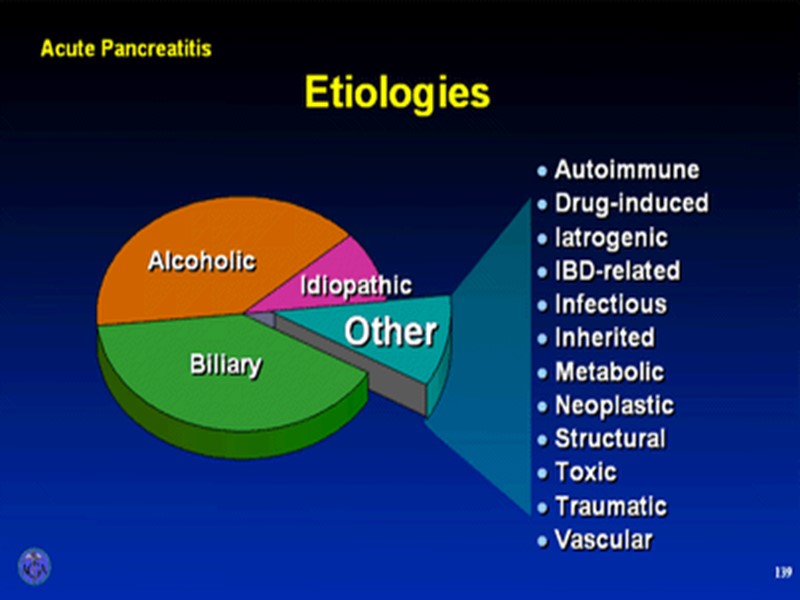

Which of the following drugs is well known for it’s ability to induce pancreatitis? Propranolol Erythromycin Azathioprin Codein
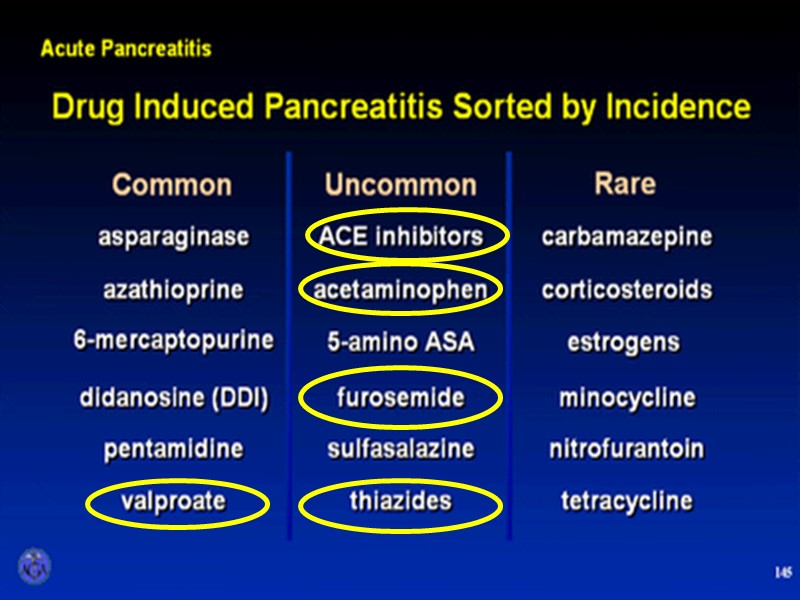
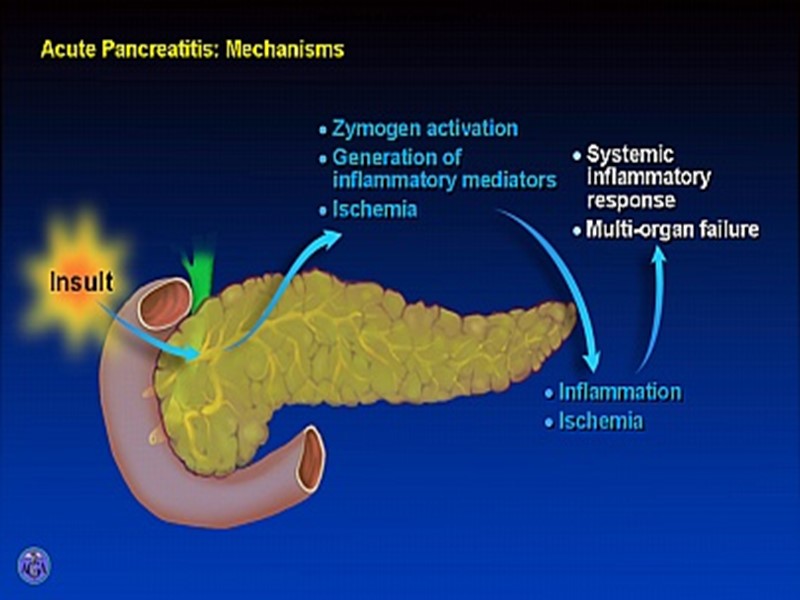
AGA Institute
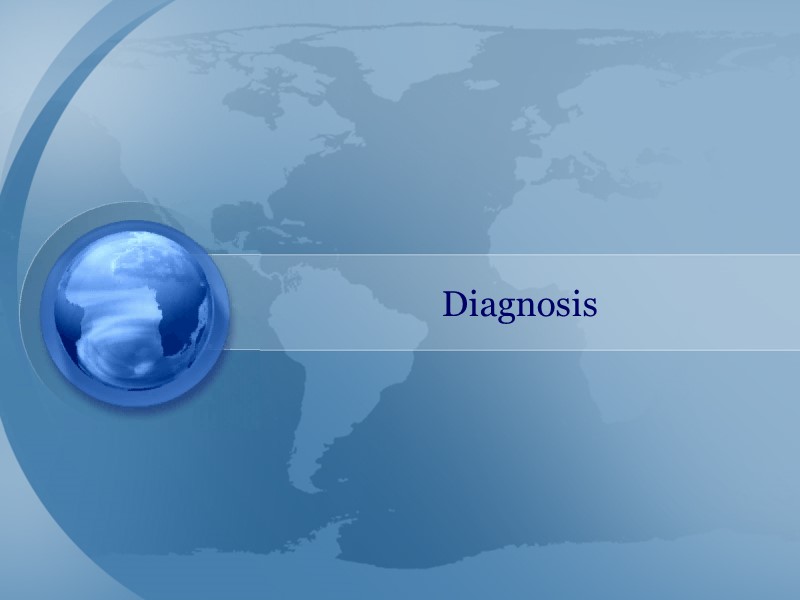
Diagnosis
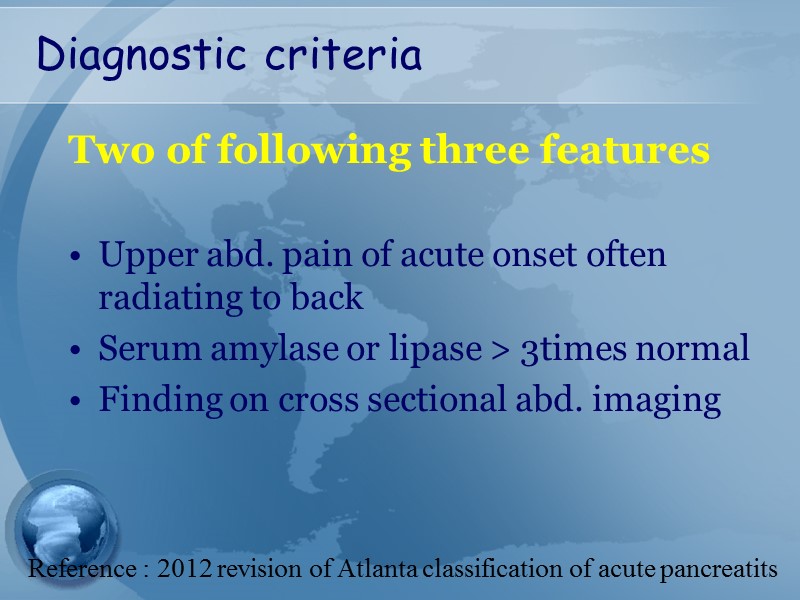
Diagnostic criteria Two of following three features Upper abd. pain of acute onset often radiating to back Serum amylase or lipase > 3times normal Finding on cross sectional abd. imaging Reference : 2012 revision of Atlanta classification of acute pancreatits
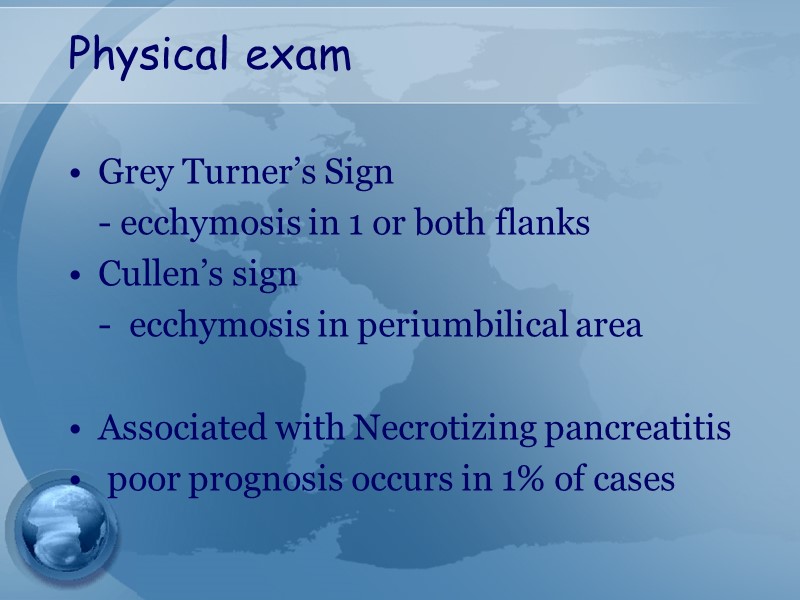
Physical exam Grey Turner’s Sign - ecchymosis in 1 or both flanks Cullen’s sign - ecchymosis in periumbilical area Associated with Necrotizing pancreatitis poor prognosis occurs in 1% of cases
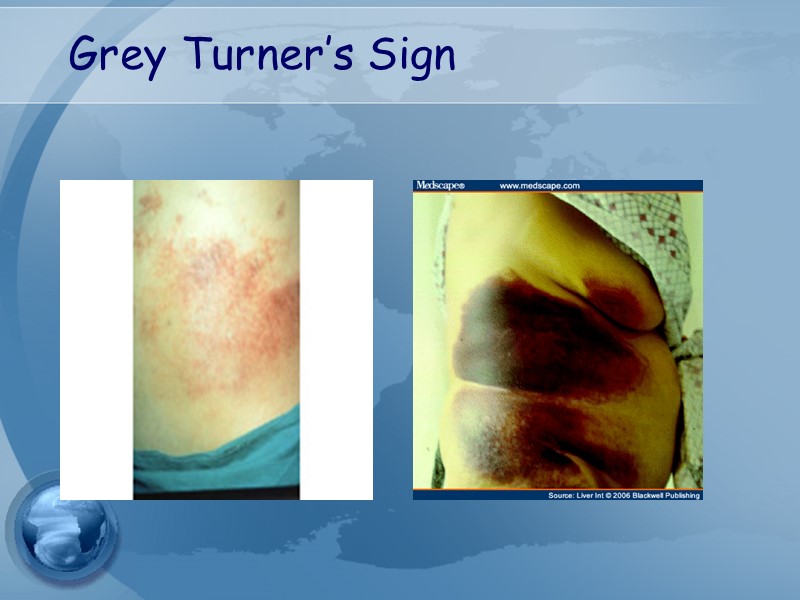
Grey Turner’s Sign
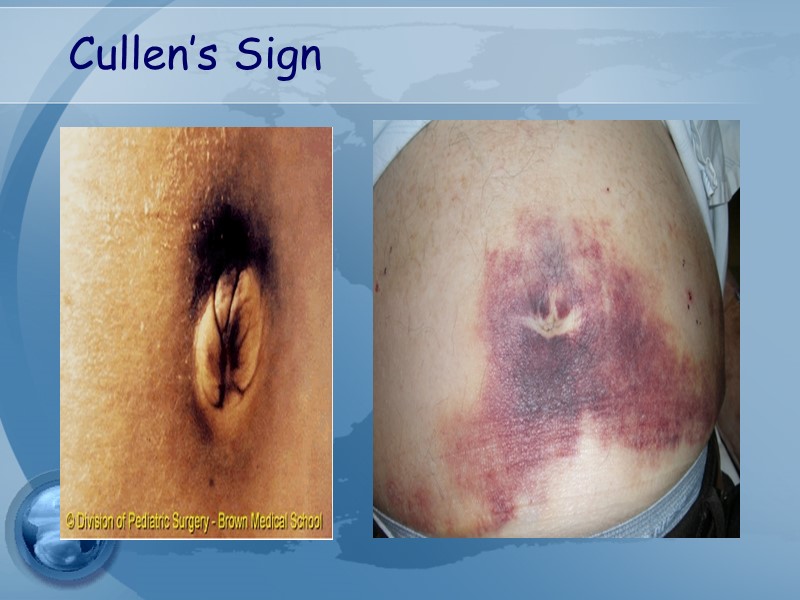
Cullen’s Sign
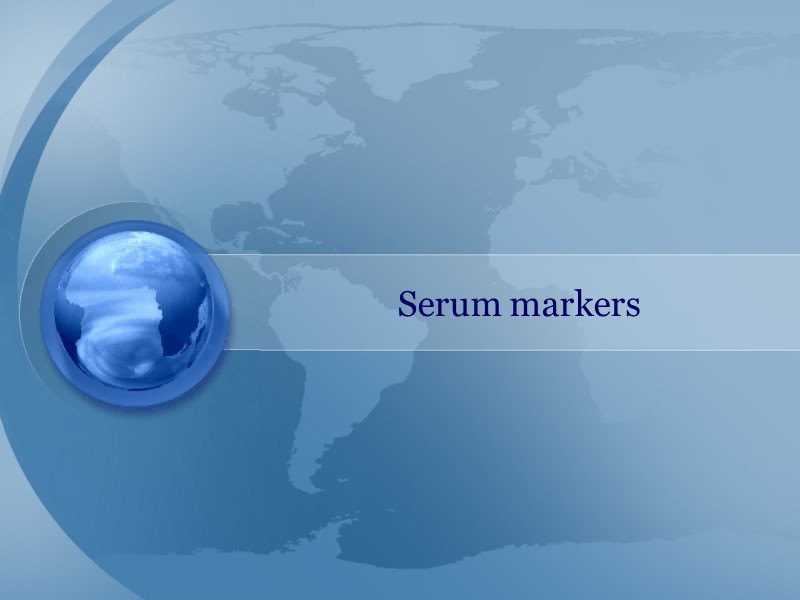
Serum markers

Serum amylase Elevates within HOURS and can remain elevated for 3-5 days High specificity when level >3x normal Many false positives Most specific = pancreatic isoamylase (fractionated amylase)
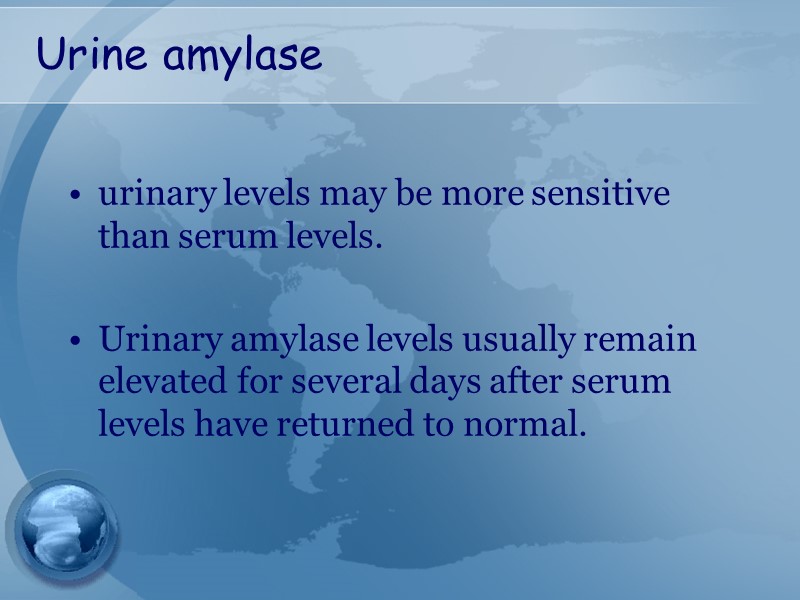
Urine amylase urinary levels may be more sensitive than serum levels. Urinary amylase levels usually remain elevated for several days after serum levels have returned to normal.
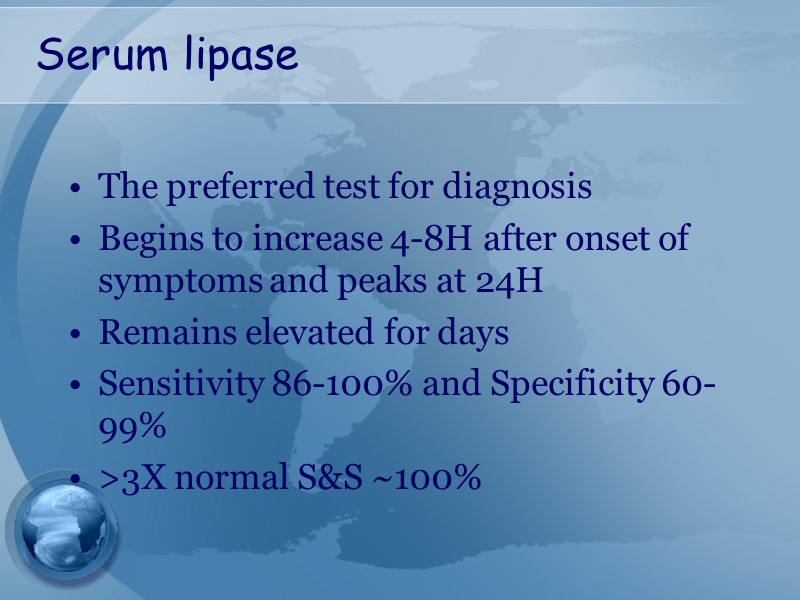
Serum lipase The preferred test for diagnosis Begins to increase 4-8H after onset of symptoms and peaks at 24H Remains elevated for days Sensitivity 86-100% and Specificity 60-99% >3X normal S&S ~100%
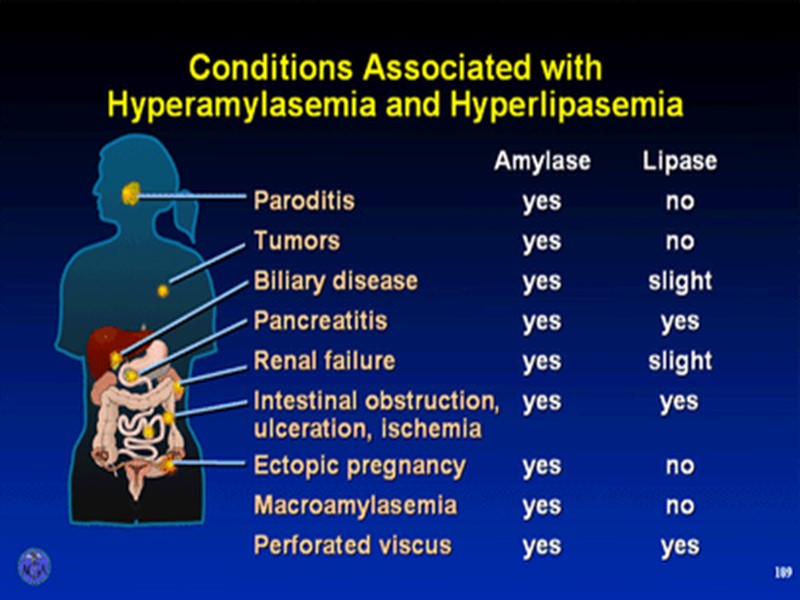

Plain Abdominal Radiograph
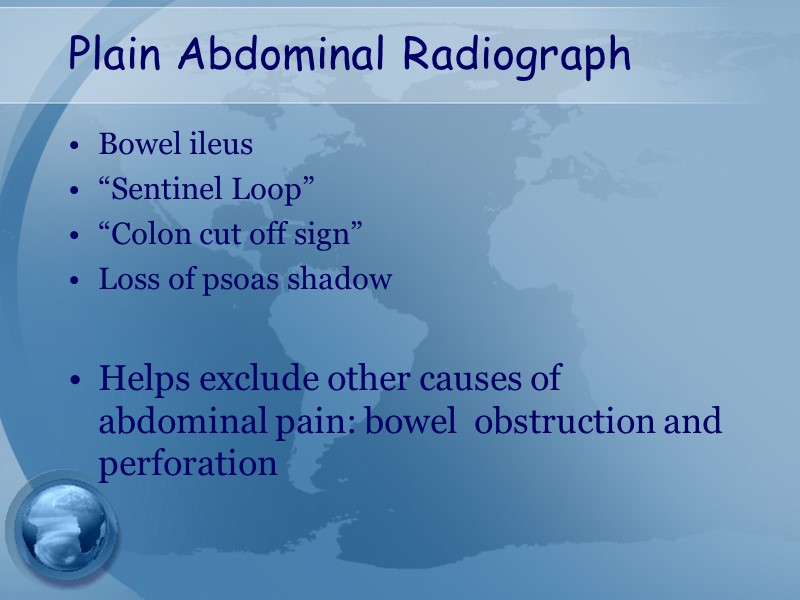
Plain Abdominal Radiograph Bowel ileus “Sentinel Loop” “Colon cut off sign” Loss of psoas shadow Helps exclude other causes of abdominal pain: bowel obstruction and perforation

Radiologic Findings Plain radiographs contribute little Ultrasound may show the pancreas in only 25-50% CT scan provides better information Severity and prognosis Exclusion of other diseases EUS & MRI with MRCP – cause of pancreatitis
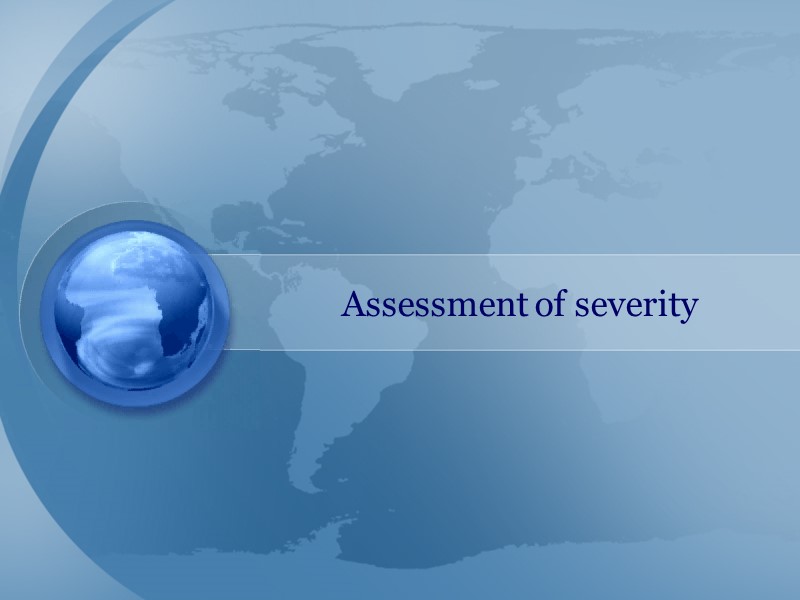
Assessment of severity
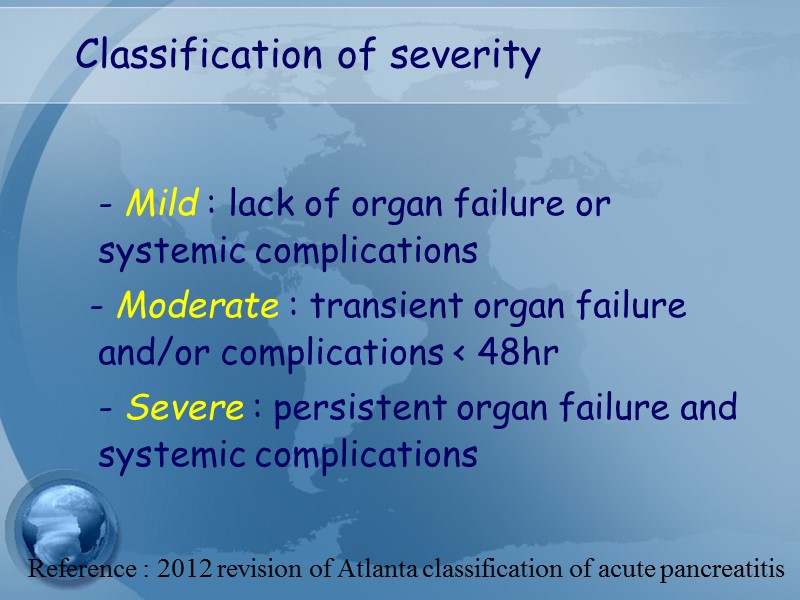
Classification of severity - Mild : lack of organ failure or systemic complications - Moderate : transient organ failure and/or complications < 48hr - Severe : persistent organ failure and systemic complications Reference : 2012 revision of Atlanta classification of acute pancreatitis
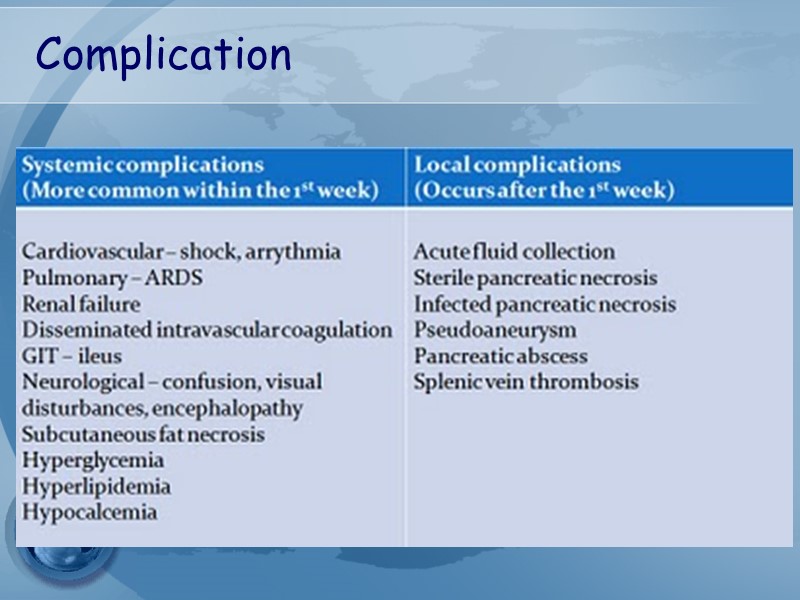
Complication
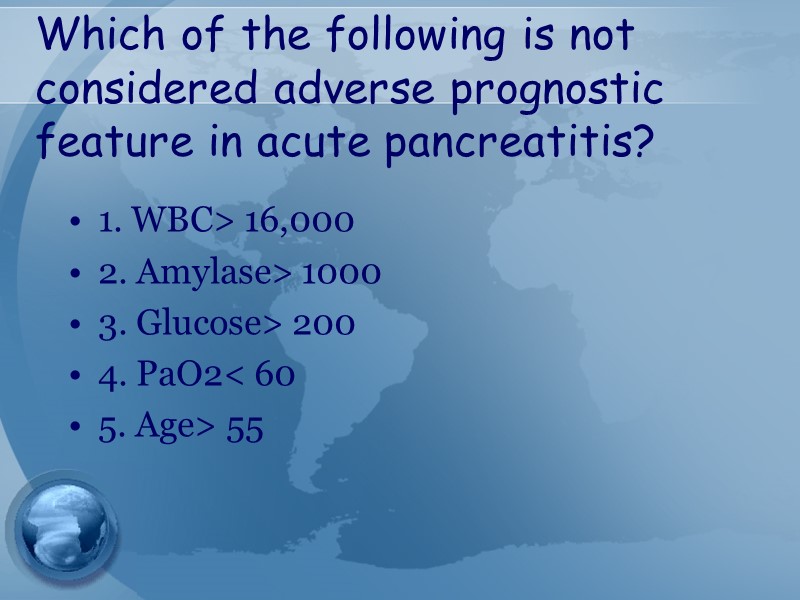
Which of the following is not considered adverse prognostic feature in acute pancreatitis? 1. WBC> 16,000 2. Amylase> 1000 3. Glucose> 200 4. PaO2< 60 5. Age> 55
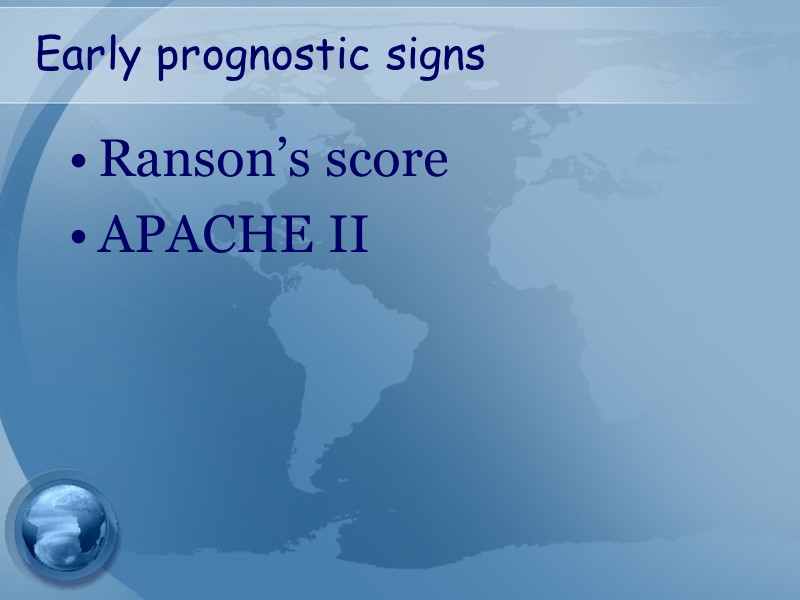
Early prognostic signs Ranson’s score APACHE II
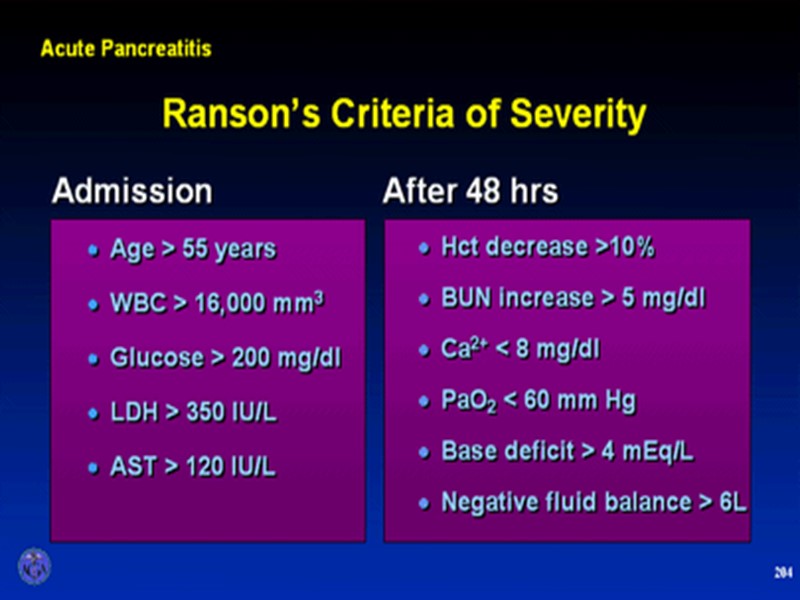
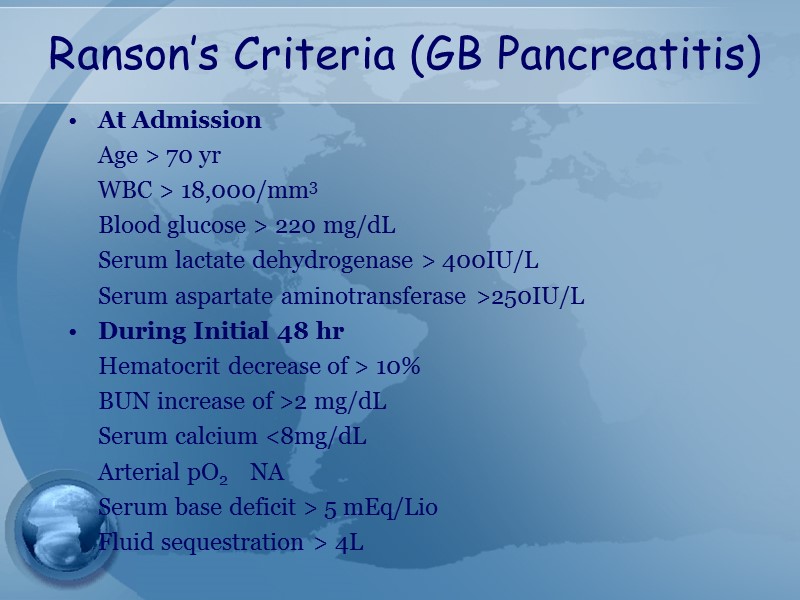
Ranson’s Criteria (GB Pancreatitis) At Admission Age > 70 yr WBC > 18,000/mm3 Blood glucose > 220 mg/dL Serum lactate dehydrogenase > 400IU/L Serum aspartate aminotransferase >250IU/L During Initial 48 hr Hematocrit decrease of > 10% BUN increase of >2 mg/dL Serum calcium <8mg/dL Arterial pO2 NA Serum base deficit > 5 mEq/Lio Fluid sequestration > 4L

APACHE II Measure at during the first 24 hours after admission Using a cutoff of ≥8 The American Gastroenterological Association (AGA) recommends: Prediction of severe disease by the APACHE II system
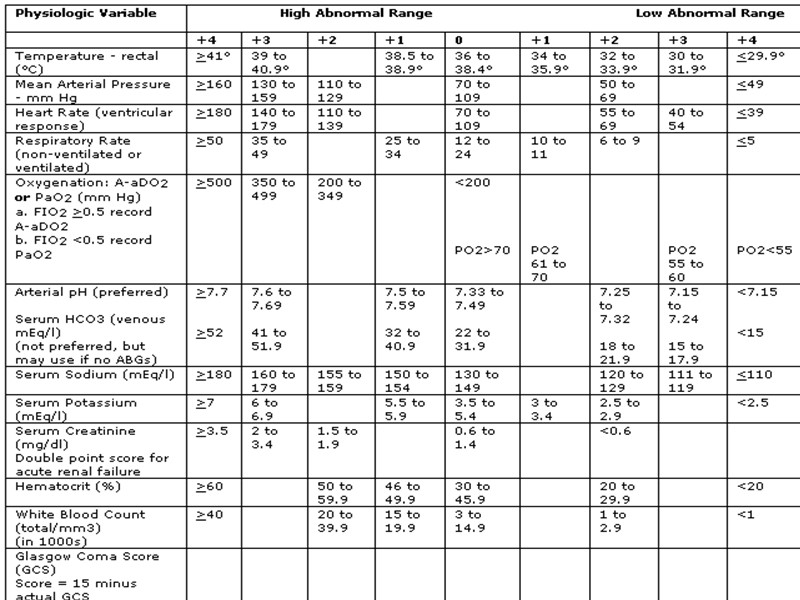
APACHE II
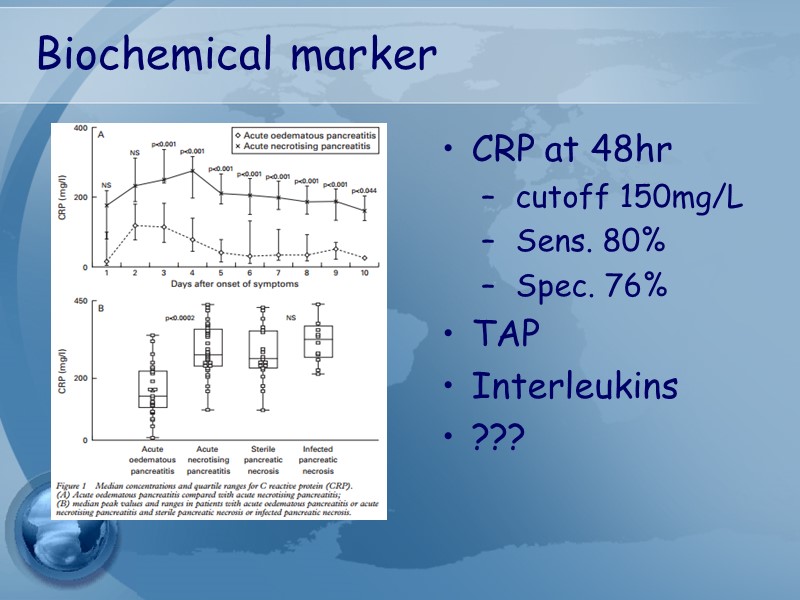
Biochemical marker CRP at 48hr cutoff 150mg/L Sens. 80% Spec. 76% TAP Interleukins ???
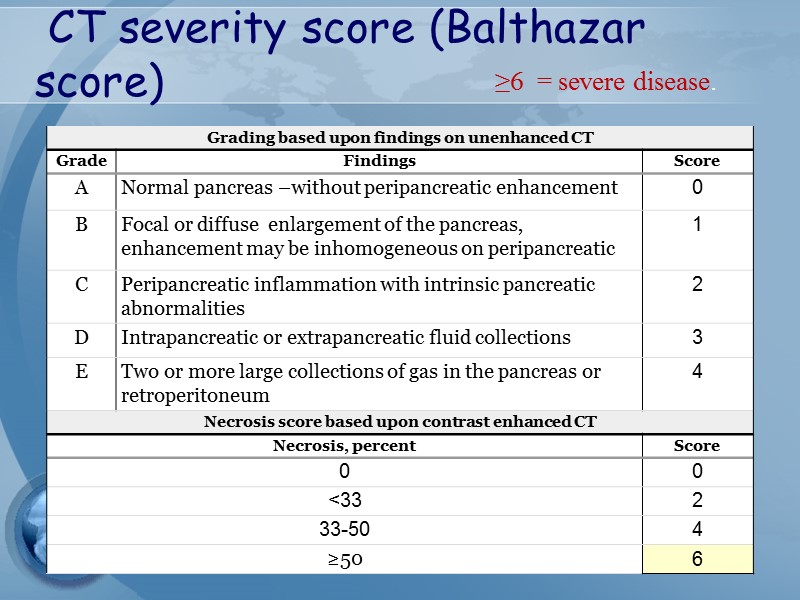
CT severity score (Balthazar score) ≥6 = severe disease.
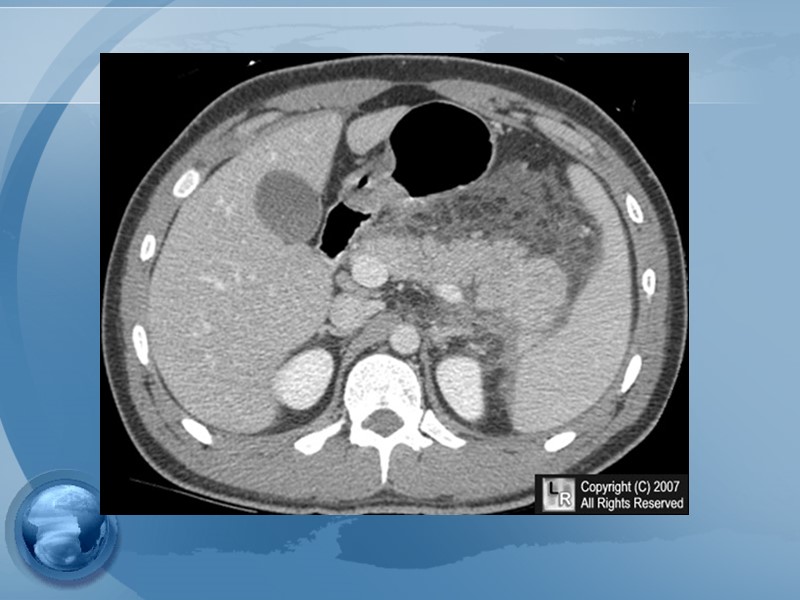
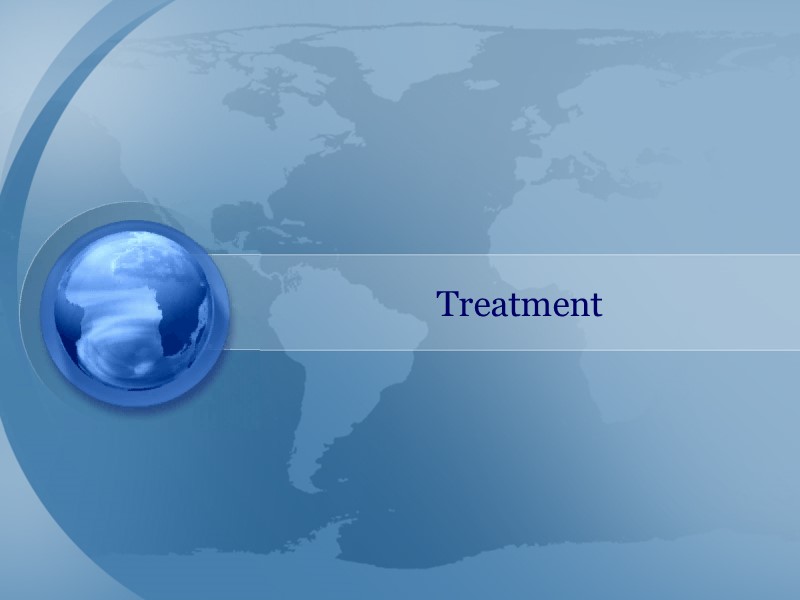
Treatment
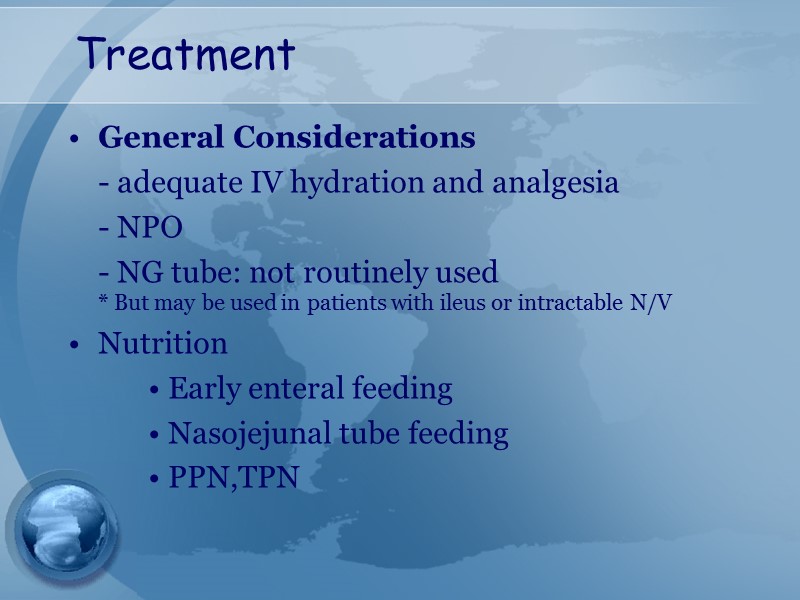
Treatment General Considerations - adequate IV hydration and analgesia - NPO - NG tube: not routinely used * But may be used in patients with ileus or intractable N/V Nutrition Early enteral feeding Nasojejunal tube feeding PPN,TPN
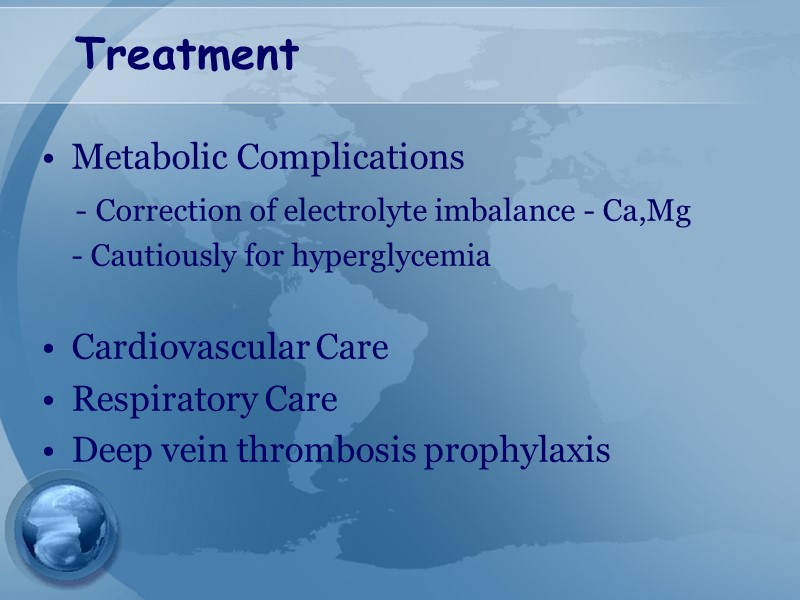
Treatment Metabolic Complications - Correction of electrolyte imbalance - Ca,Mg - Cautiously for hyperglycemia Cardiovascular Care Respiratory Care Deep vein thrombosis prophylaxis

Prophylactic antibiotics Although this is still an area of debate Not indicated for mild attack suggest imipenem or meropenem for 14 days for patients with proven necrosis
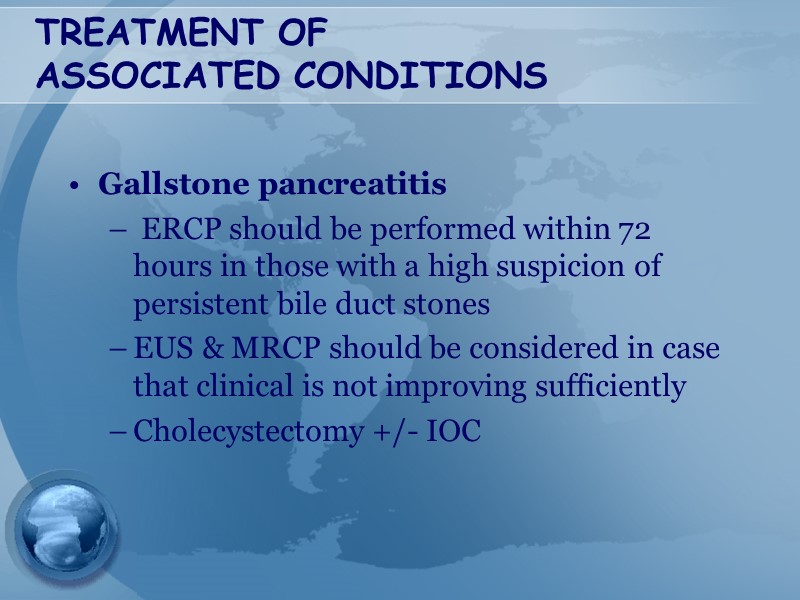
TREATMENT OF ASSOCIATED CONDITIONS Gallstone pancreatitis ERCP should be performed within 72 hours in those with a high suspicion of persistent bile duct stones EUS & MRCP should be considered in case that clinical is not improving sufficiently Cholecystectomy +/- IOC
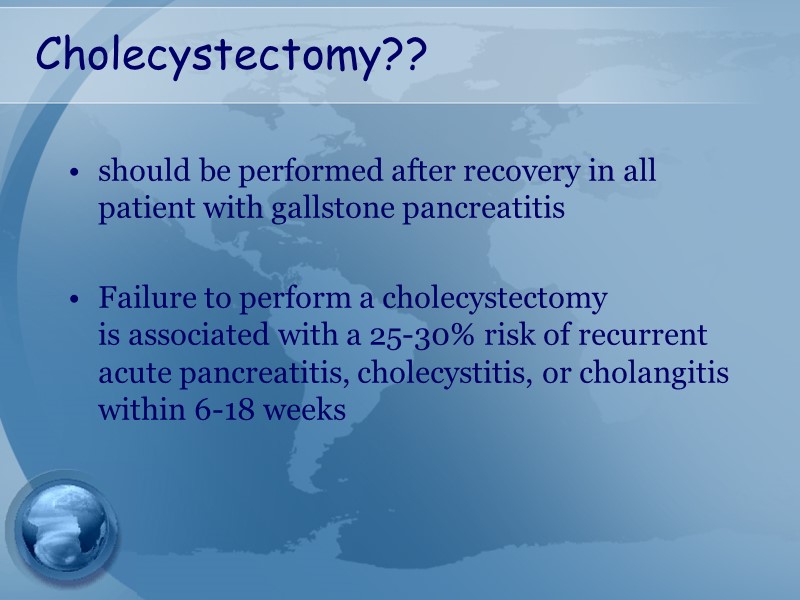
Cholecystectomy?? should be performed after recovery in all patient with gallstone pancreatitis Failure to perform a cholecystectomy is associated with a 25-30% risk of recurrent acute pancreatitis, cholecystitis, or cholangitis within 6-18 weeks

Cholecystectomy In mild pancreatitis case, can usually be performed safely within 7 days after recovery In severe pancreatitis case ,delaying for at least 3 wks may be reasonable If high suspicion of CBD stones, preoperative ERCP is the best test that therapeutic intervention will be required If low suspicion,intraoperative cholangiogram during cholecystectomy may be preferable to avoid the morbidity associated with ERCP
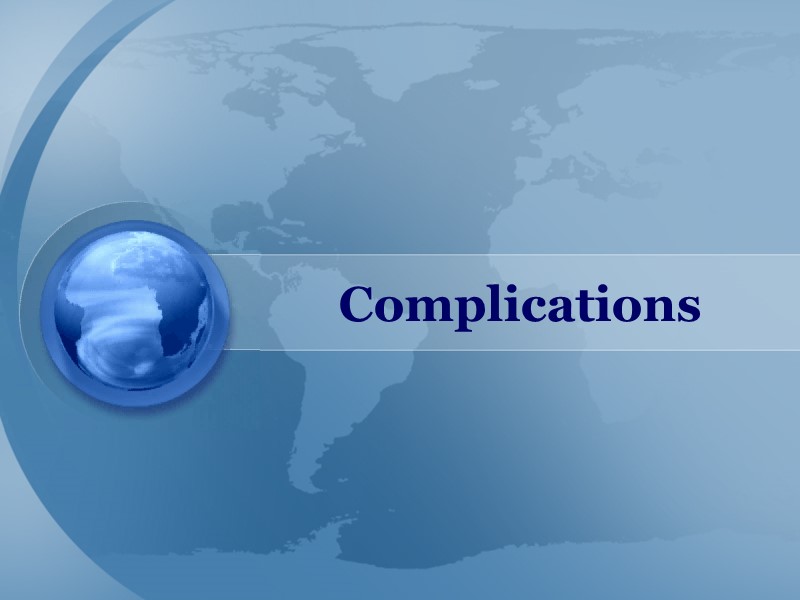
Complications
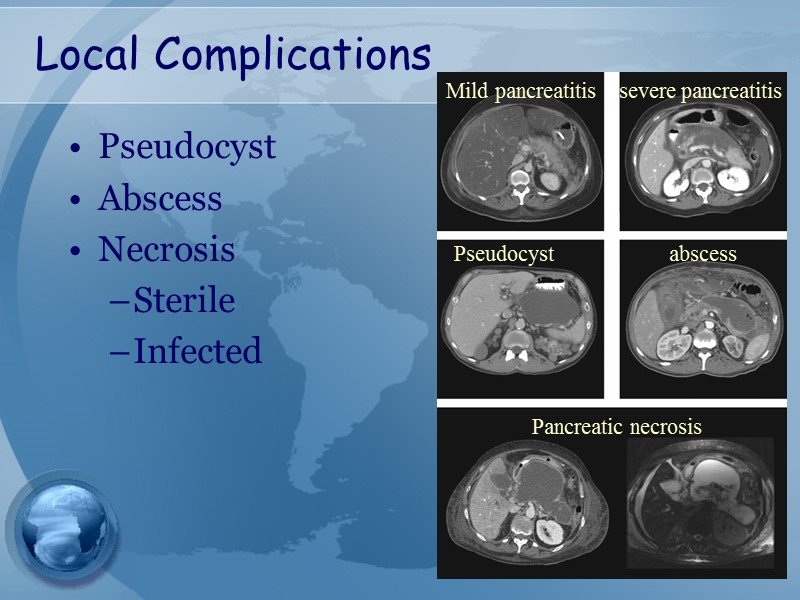
Local Complications Pseudocyst Abscess Necrosis Sterile Infected Mild pancreatitis severe pancreatitis Pseudocyst abscess Pancreatic necrosis
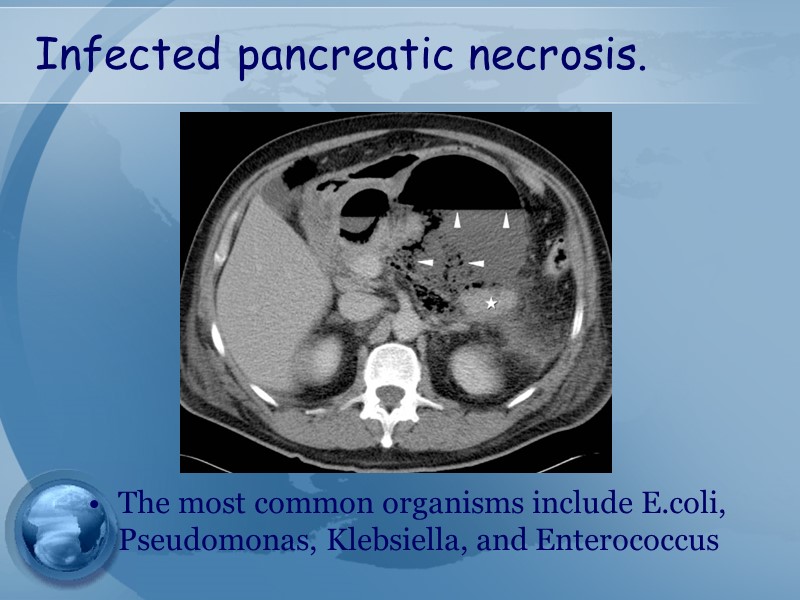
Infected pancreatic necrosis. The most common organisms include E.coli, Pseudomonas, Klebsiella, and Enterococcus
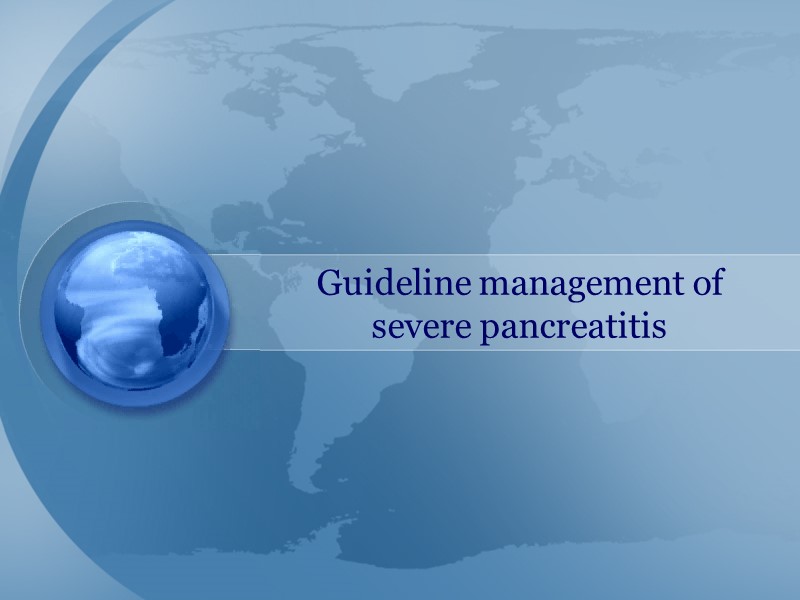
Guideline management of severe pancreatitis
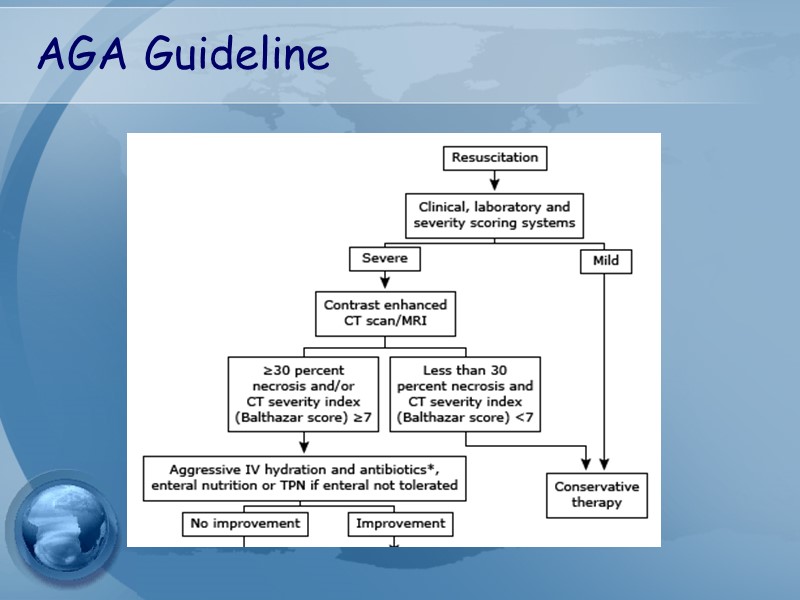
AGA Guideline

Surgical debridement
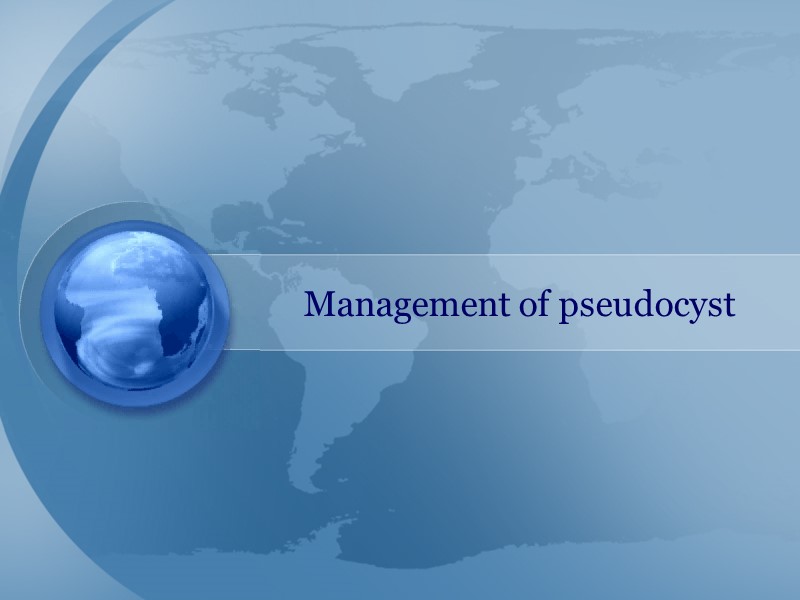
Management of pseudocyst
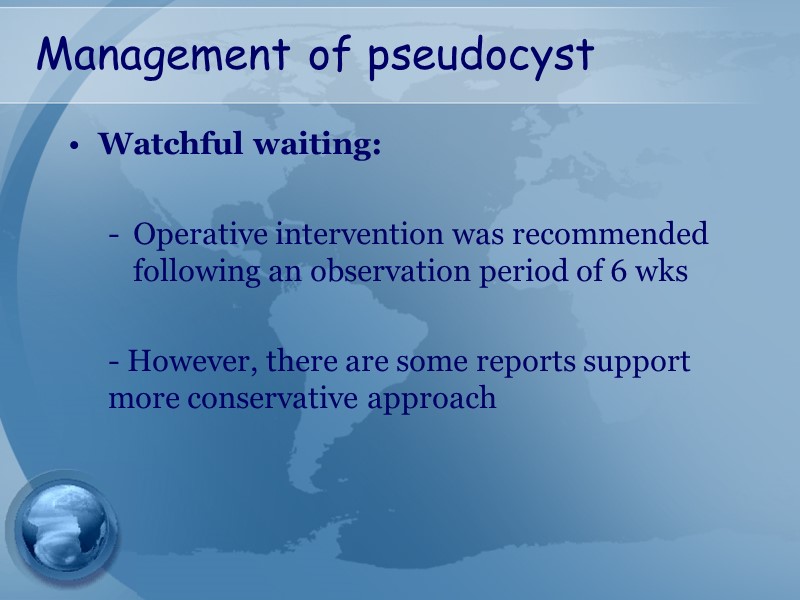
Management of pseudocyst Watchful waiting: Operative intervention was recommended following an observation period of 6 wks - However, there are some reports support more conservative approach
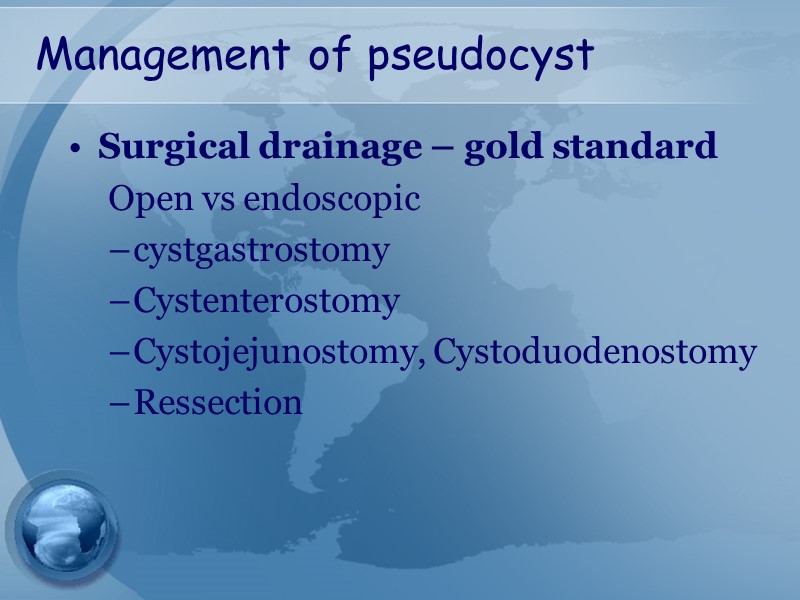
Management of pseudocyst Surgical drainage – gold standard Open vs endoscopic cystgastrostomy Cystenterostomy Cystojejunostomy, Cystoduodenostomy Ressection
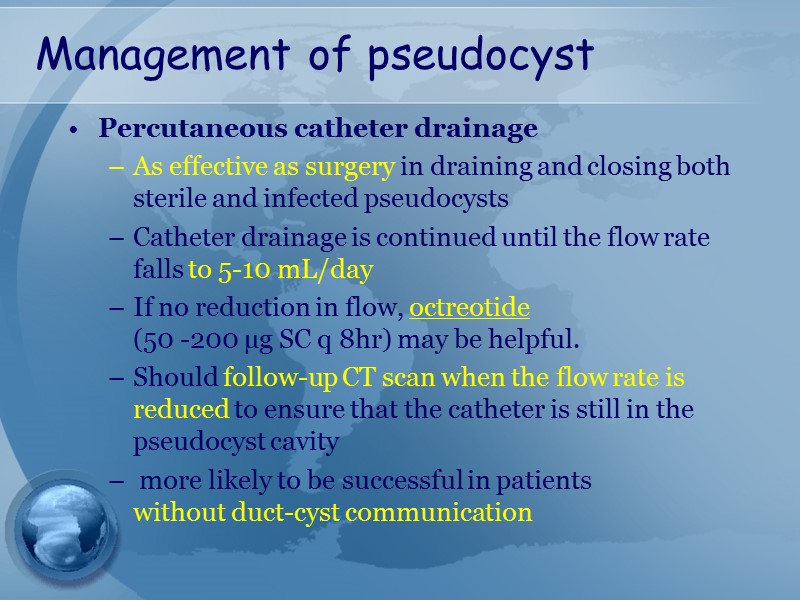
Management of pseudocyst Percutaneous catheter drainage As effective as surgery in draining and closing both sterile and infected pseudocysts Catheter drainage is continued until the flow rate falls to 5-10 mL/day If no reduction in flow, octreotide (50 -200 µg SC q 8hr) may be helpful. Should follow-up CT scan when the flow rate is reduced to ensure that the catheter is still in the pseudocyst cavity more likely to be successful in patients without duct-cyst communication
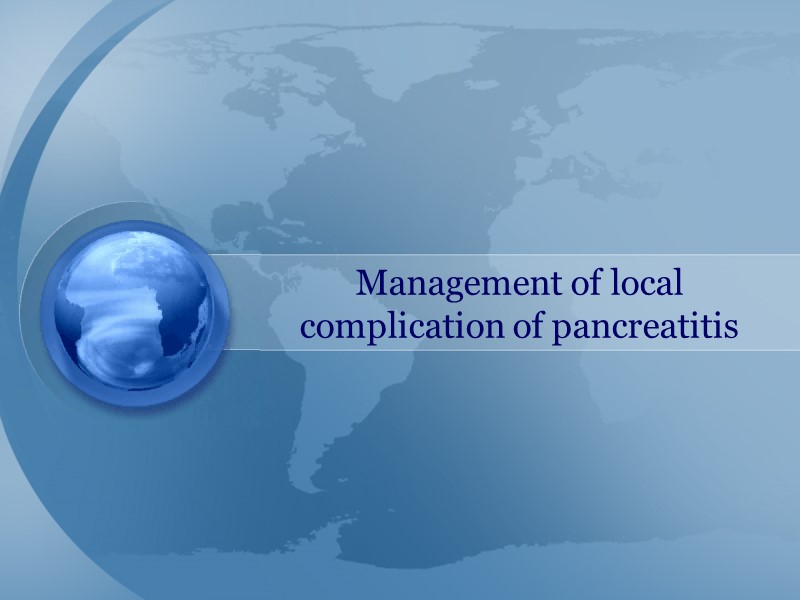
Management of local complication of pancreatitis
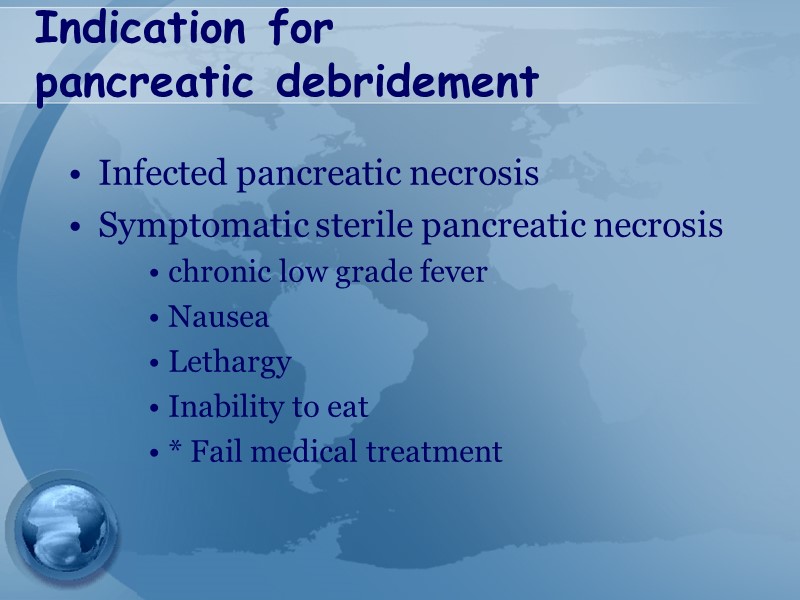
Indication for pancreatic debridement Infected pancreatic necrosis Symptomatic sterile pancreatic necrosis chronic low grade fever Nausea Lethargy Inability to eat * Fail medical treatment
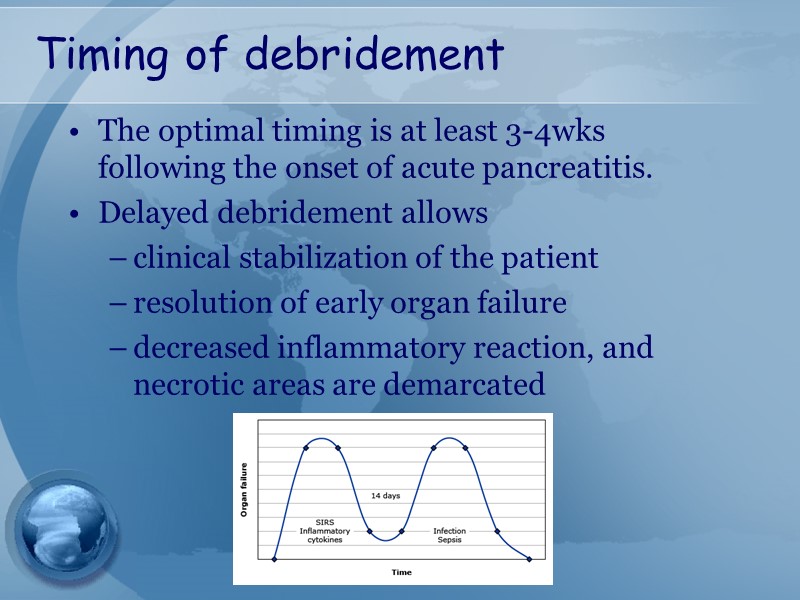
Timing of debridement The optimal timing is at least 3-4wks following the onset of acute pancreatitis. Delayed debridement allows clinical stabilization of the patient resolution of early organ failure decreased inflammatory reaction, and necrotic areas are demarcated

Thank You
25058-pancreatitis_eddie.ppt
- Количество слайдов: 60

